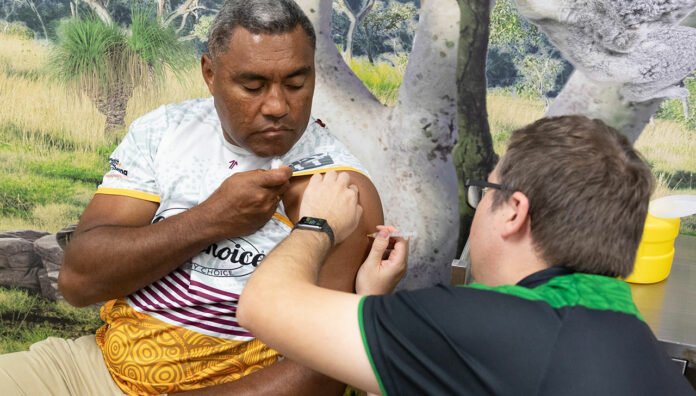Community pharmacists delivered their first COVID-19 vaccinations in Queensland this week, and more are expected to come online soon in other states. Now is the time to prepare to join the rollout, according to PSA CEO Mark Kinsela.
There are currently 49 community pharmacies in rural and remote Queensland able to provide COVID-19 vaccinations, and PSA is working with governments to expand this into other states.
‘We look forward to a couple of announcements very shortly in this space, particularly those in rural and remote areas with low penetration of general practice,’ Mr Kinsela told attendees at a PSA webinar last night (8 June).
It is expected community pharmacies will be ‘brought online in a more substantive way, in metro areas as well, from September or October,’ he added.
Community pharmacists currently have access to the AstraZeneca vaccine but, with the Therapeutic Goods Administration approving more flexible storage arrangements for the Pfizer COVID-19 vaccine and the Moderna vaccine set to rollout from November, Mr Kinsela said it was ‘highly likely that community pharmacies will be delivering multiple types of vaccines by the end of this year’.
‘We are putting a lot of pressure on government, like many across the sector, to move faster on community pharmacies to start vaccinating,’ he said.
Top tips
Pharmacists have been involved in the vaccine rollout since the start, whether in general practice, hospitals, bulk vaccination clinics or aged care, and Mr Kinsela thanked those involved for their efforts.
‘I just want to say congratulations to all the pharmacists who have been delivering excellent work, for example in strategic roles, coordinating supply chains and cold chain management, drawing up vaccines and supervising the vaccine teams,’ he said.
‘You are doing an outstanding job creating fantastic multidisciplinary teams responsible for the vaccine effort … There are amazing pharmacists doing really great things.’
One such pharmacist is Matthew Hoy MPS, who began administering the AstraZeneca vaccine to Aboriginal and Torres Strait Islander patients at the Institute for Urban Indigenous Health (IUIH) in Queensland in March.
He shared his top tips for other pharmacist immunisers during the webinar, including ensuring pharmacists remain abreast of the latest information. PSA’s COVID-19 microsite is a good resource.
‘It’s a rapidly evolving space,’ Mr Hoy said. ‘Being up-to-date with all the changes is important … Not just doing the mandatory training that the government sets, but keeping updated so you can answer the questions you’ll get asked when patients come in.’
Pharmacists should also be prepared to spend longer with patients than they usually would.
‘More so than any other vaccine we’ve administered in the past … [the COVID-19 vaccine] often generates a lot of extra questions and it’s just about allocating time to address people’s concerns,’ he said.
Mr Hoy’s clinic initially booked 15-minute appointments per vaccination, not including the screening questions, with the aim of reducing this to 10 minutes as the team built up experience.
‘However, as we learnt, people had lots of questions with the COVID vaccine and we needed to allow extra time,’ he said.
‘We ended up continuing with the 15-minute slot, but with a lot of leeway. For example, we have multiple vaccinators on site, so if we need to spend more time with a particular patient we can, and we can also accommodate walk-ins.’
PSA National President Associate Professor Chris Freeman, a GP pharmacist who also began vaccinating patients in March, said his clinic also started with 15-minute appointments.
‘We started by spacing out our bookings quite significantly, just to give us a bit of time and make sure the vaccinator didn’t feel under pressure in the consultation to get to the next patient,’ A/Prof Freeman told webinar attendees.
‘Once you become more comfortable, then you can start going back to an ordinary booking process as you would have for influenza.’
COVID-19 vaccine appointments at the medical centre now take about 7–10 minutes per person, not including the patient’s arrival and post-vaccine observation, with breaks scheduled throughout the day in case the team falls behind.
Mapping out the process, from receiving the vaccine through to delivery and reporting, has also made life easier.
‘You can build on some of the processes that you’ve already developed with the other vaccines that you deliver through community pharmacy,’ A/Prof Freeman said.
‘If you have a really good process map, anyone in the pharmacy who needs to know about the process can go to a central document that you’ve built to understand it.’
A/Prof Freeman also recommended taking the time to do a ‘dry run’ before getting started.
‘After the medical centre had closed one day, we had all our staff involved in the vaccine rollout with 10 “patients” going through the whole process,’ he said.
‘That was good to give everyone a bit of confidence, but also let us understand the timing of the different phases.
‘It’s really important to do that in practice so that you’re very clear on the day when you actually start the vaccination.’
Did you miss the webinar? PSA members can watch a recording here.



 John Jones MPS, pharmacist immuniser and owner of My Community Pharmacy Shortland in Newcastle, NSW[/caption]
John Jones MPS, pharmacist immuniser and owner of My Community Pharmacy Shortland in Newcastle, NSW[/caption]


 Debbie Rigby FPS explaining how to correctly use different inhaler devices[/caption]
Debbie Rigby FPS explaining how to correctly use different inhaler devices[/caption]




 Professor Sepehr Shakib[/caption]
Professor Sepehr Shakib[/caption]

 Lee McLennan MPS[/caption]
Lee McLennan MPS[/caption]
 Dr Natalie Soulsby FPS, Adv Prac Pharm[/caption]
Dr Natalie Soulsby FPS, Adv Prac Pharm[/caption]
 Joanne Gross MPS[/caption]
Joanne Gross MPS[/caption]





